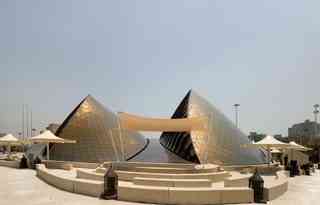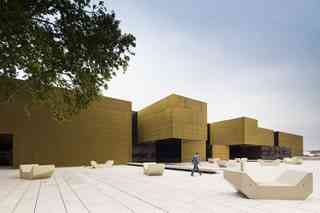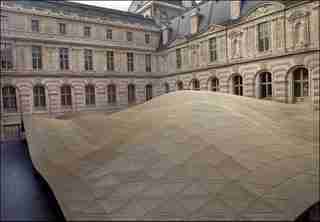The 10 Most Beautifully Designed Gold-Covered Structures Around the World
In an architectural landscape of slick glazed façades and cold silver-metal exteriors, a golden building is a rare treat for the eyes. Not only does it stand apart from its surroundings, but it can bring an unexpected warmth to the sometimes unforgiving geometric lines of modern structures. A gold-toned edifice is nothing new—gold leaf has been used in architecture for centuries—but contemporary buildings are bringing new dimension to the color through alloyed metals and contrasting materials. And while actual gold isn’t typically used, the hue itself adds a certain prized look to whatever it covers, elevating a building from celebrated to cherished. What follows are notable examples of golden architecture by the likes of Frank Gehry , Rafael Viñoly , and Foster + Partners.

Shanghai Expo 2010
Inspired by the rolling sand dunes of the United Arab Emirates, the UAE Pavilion for China's 2010 Shanghai Expo by Foster + Partners features undulating panels of gold-tinted stainless steel. The distinctive roofline was designed to be as environmentally efficient as possible by orienting the panels to deflect wind and let in sunlight on the north elevation while blocking it on the southern side.

Platform of Arts and Creativity
Panels of rectangular brass pipes form the ridged, golden-hued façade of Guimarães, Portugal’s Platform of Arts and Creativity, completed in 2012 by Pitagoras Arquitectos. Constructed adjacent to existing buildings in the city’s market square, the modular complex has work space and exhibition rooms for artists, as well as a permanent gallery devoted to local artist Jose de Guimarães.

Department of Islamic Art at the Louvre
Triangles of glass—sandwiched by gold-tone anodized aluminum—form the wavelike roof of the Louvre’s Department of Islamic Art, completed by architects Mario Bellini and Rudy Ricciotti in 2012. Situated in the museum’s Cour Visconti courtyard, the structure features one floor aboveground and two below, all holding more than 2,500 works of art.
Hotel Marques de Riscal
Seen here are Frank Gehry’s signature fluid architectural forms on the Hotel Marqués de Riscal in Spain, this time rendered in sheets of titanium that were tinted gold, silver, and purple. The breathtaking structure, finished in 2006, revitalized the site’s namesake winery, which dates from 1858. The building also made a perfect aesthetic companion to Gehry’s other wavy masterpiece in Spain, the Guggenheim Bilbao.
Departmental Archives of Rhône
The Departmental Archives of Rhône in Lyon, France, features a gleaming façade of copper-and-aluminium alloyed panels. Conceived as a modular structure—made up of stacked boxlike volumes—the municipal building was completed in 2014 by Gautier+Conquet Architectes with a base made of black granite and glass-encased offices at the top.
The Monolithe
Also in Lyon is Le Monolithe, a 2010 residential and commercial complex built in five sections, each by different architects. Seen here is the design by ECDM’s Emmanuel Combarel and Dominique Marrec, a building with a stamped concrete skin in a warm gold, whose angles and facets create a pixelated appearance.
Pro Aurum Gold Trading
Completed in 2009 as office space for its namesake company, the Pro Aurum building in Munich features an exterior of appropriately colored copper alloy shingles. Conceived by architect Rainer Freitag, the building also features horizontal shutters—some running almost the entire length of the structure—that blend in with the façade when folded down.
Colston Hall
First built in 1867, the Colston Hall concert venue in Bristol, England, received a shining copper-alloy-clad foyer in 2009, courtesy of the architects at Levitt Bernstein. This addition, with its façade made up of 70 percent recycled material, marked the first phase of a complete renovation of the historic music hall; it also creates a striking contrast to the original Byzantine-style architecture.
Firstsite
Named for its location on one of the first Roman settlements in the U.K., the art gallery Firstsite in Bristol, England, has an eye-catching exterior made of copper-aluminum panels in a herringbone pattern. Completed in 2011 by Rafael Viñoly Architects, the crescent-shaped structure hosts only one permanent art exhibit—a restored mosaic set into one room’s floor.
Bibliothek Luckenwalde Annex
This slanted structure—clad in copper-aluminum panels—is an annex to the Bibliothek Luckenwalde, a public library in the namesake town of Germany. Designed by architects Ralf Fleckenstein and Katharina Feldhusen at FF Architekten and completed in 2009, the glowing building houses the library’s collection for children and young adults.